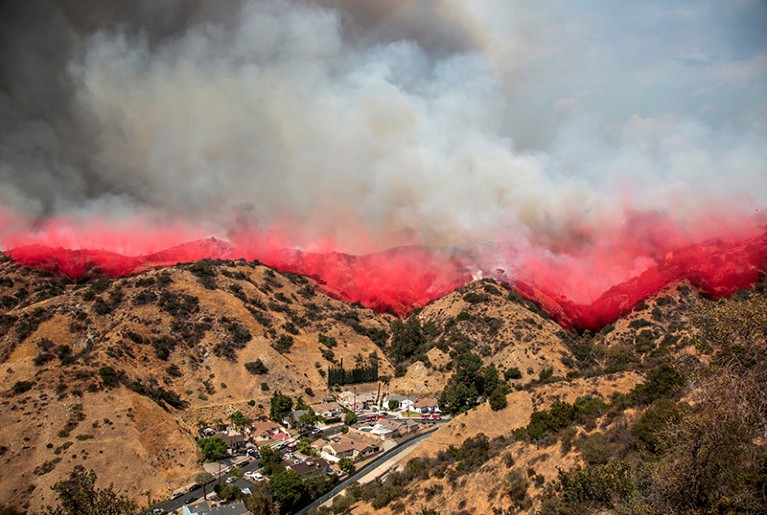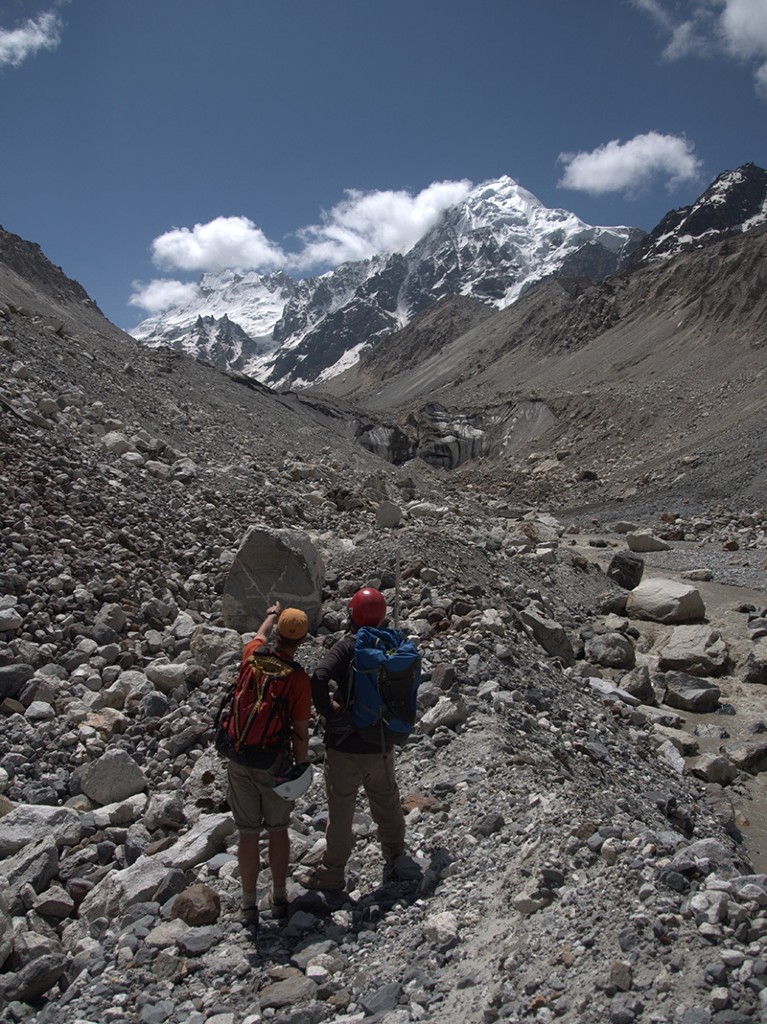
Burbank, California in 2017: scientists are assessing the Earth’s regenerative capacity after extreme events.Credit: Kyle Grillot/Reuters/PA
When Reinhard Hüttl thinks about climate change, he’s not worried about saving the planet. The ecologist and research coordinator for Earth and environment at the Helmholtz Institute in Potsdam knows the generative power of nature. “This planet will survive any kind of climate change,” he says. “It’s us who are in danger.”
In the Chicken Creek experiment in Lusatia, Germany, named after a small stream formerly on the site that was destroyed by open-cast mining in the 1980s, Hüttl and colleagues have for 12 years watched how ecosystems emerge from geological raw materials. From nutrient-poor, sandy soil, a diverse forest has grown from seeds that have washed or blown in, or were dormant in the seemingly barren soil when the experiment started. “With a little bit of rain, you see how life explodes,” says Hüttl.
Part of Nature Index 2018 Earth and Environmental Sciences
It will take more than a bit of rain, though, to nurture and protect human life on Earth. To deal with a changing climate, we need to rethink and rebuild our infrastructure, agriculture, and economies. Earth and environmental sciences incorporate a wide range of disciplines, from geology to agriculture to oceanography. Climate change has implications for almost every specialty. The most pressing goal of researchers like Hüttl at the top Earth and environmental science institutes around the world is to equip local and national governments, and the population at large, with the knowledge we will need to anticipate and mitigate the effects of climate change.
Be they climate modellers, panda-habitat experts, or soil specialists, Earth and environmental scientists are looking for answers. They’re working to model and predict the course of climate change — how fast it will happen, how extreme it will be — and to come up with solutions that will sustain existing or better ways of living in changed climate conditions.
Fast and extreme
It’s urgent work because stronger storm systems and persistent drought are already putting people’s lives and livelihoods at risk, says Waleed Abdalati, director of the Cooperative Institute for Research in Environmental Sciences (CIRES) at the University of Colorado Boulder. “There’s no question we’ll be better positioned the sooner we figure things out,” he says.

Fieldwork in Nepal supports CIRES climate modelling.Credit: Allen Pope/National Snow and Ice Data Center/CU Boulder
At the Climate Change Research Centre at the University of New South Wales in Sydney, its director, Katrin Meissner, tests the predictive power of today’s climate models against historical temperature data. These models, built using data from the relatively stable recent past, are good at making predictions when conditions aren’t too extreme, so are considered reliable in the near term. But Meissner says their temperature predictions are less accurate at extremely high atmospheric carbon dioxide concentrations, which have occurred in the past, and are expected again. The models predict lower temperatures than the records show when they are fed historical data from more extreme eras. “They are too cold, especially at the poles,” says Meissner. That means existing models may underestimate the speed and scope of future sea-level rise, among other things.
To make models that are more accurate in the face of future extremes, Meissner and others are trying to get fuller data on what’s missing: the biogeochemistry that describes how chemicals and nutrients, such as nitrogen and carbon, travel through the planet’s physical systems, ecosystems and atmospheric systems, including clouds. “There’s a lot of work to be done just to understand the basic equations,” she says.
Atmospheric chemist, Paul Wennberg, who directs the Ronald and Maxine Linde Center for Global Environmental Science at Caltech, says emerging technologies will help. Climate scientists are adopting machine-learning techniques to train their models to make better predictions from the data. “The calculations will allow models to learn what they can’t directly calculate,” he says.
Political climate
The United States is still the leading producer of high-quality research in Earth and environmental sciences, according to analysis by the Nature Index. But the country’s researchers can no longer take that status for granted.
US President Donald Trump’s administration, with its moves to loosen pollution controls and threats to cut funding for scientific research, has caused what Christopher Field, director of the Stanford Woods Institute for the Environment, tactfully calls “a new wrinkle” in climate policy.
Although the US Congress has not so far cut science funding, US researchers can find themselves hamstrung in other ways. Caltech’s Wennberg cannot directly collaborate with peers in China — nor can any other scientist who, like him, receives funding from the National Aeronautics and Space Administration. This rule was established by Congress in 2011 and has been upheld since. In addition to being the country’s space agency, NASA is a major funder of Earth and environmental sciences research in the US.
China has the strongest growth of the top ten countries in Earth and environmental science research in Nature Index’s analysis. Sustainable development is a big focus of environmental research in his country, says Ouyang Zhiyun, deputy director of the Research Center for Eco-Environmental Sciences at the Chinese Academy of Sciences (CAS) in Beijing. He says air pollution monitoring and control, as well as water treatment, are major areas of research at the centre.

Source: Nature Index
Ouyang’s centre also makes science-based recommendations about land use, including identifying areas where development will have minimal environmental impacts.
The country has been aggressive about reforestation, spending US$100 billion on such efforts over the last decade. But conservationists have criticized reforestation efforts for large plantings of single species of trees, for defining ‘forest’ loosely, and for planting trees in areas that don’t have the right climate or terrain to support diverse forest ecosystems.
Ouyang’s team is collaborating with researchers at the Natural Capital Project led by Gretchen Daily at Stanford University, who have developed software to identify where a nature preserve or reforestation effort will have the greatest benefits. The CAS centre is now training thousands of government officials and researchers in how to use the decision-making software. “Good ideas will get support from the government,” Ouyang says. He says environmental research is gaining support in China because citizens and government officials alike have directly experienced the negative consequences of rapid development and environmental degradation such as air pollution, sand storms and flooding.
Still, Earth and environmental scientists are worried that climate action is moving too slowly globally. Meissner would like to see more policies in place to encourage renewable energy and restrict carbon dioxide emissions.
Though they hear the climate-change clock ticking, most environmental scientists are not moved to get involved in politics, with a few notable exceptions. Andrew Weaver, leader of the Green party in British Columbia, Canada, is a climate scientist; Montana conservationist, Grant Kier, is running for the US Senate. Kier hopes to unseat an incumbent who favours easing environmental protections, and who believes there were dinosaurs on Noah’s Ark.
However, many scientists, like Abdalati, believe that lobbying would muddy their message, and is not their role. “My function is to provide the best information so that the discourse can be built around accurate information and the best decisions can be made,” he says.

Source: Dimensions from Digital Science/Nature Index

Source: Dimensions from Digital Science/Nature Index

Source: Dimensions from Digital Science/Nature Index

 The search for solutions
The search for solutions
 Gravitational pull
Gravitational pull
 Casting a net for knowledge
Casting a net for knowledge
 Core values
Core values
 Paving the way to an urban future
Paving the way to an urban future
 Big data goes green
Big data goes green
 Zoom in on the big picture
Zoom in on the big picture
 Pooled resources
Pooled resources
 Making waves
Making waves
 A guide to the Nature Index
A guide to the Nature Index




![High carrier mobility along the [111] orientation in Cu2O photoelectrodes](https://media.nature.com/w140h79/springer-static/image/art%3A10.1038%2Fs41586-024-07273-8/MediaObjects/41586_2024_7273_Fig1_HTML.png)

